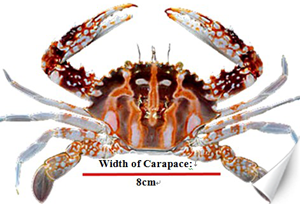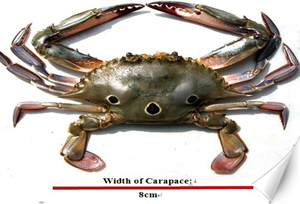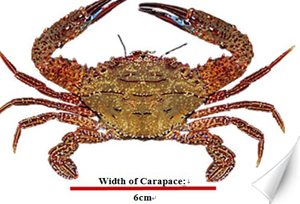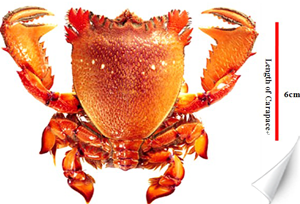Since 2012, New Taipei City not only created the “Wanli crab” brand to promote the entire fishing economy, but also held a number of explanation sessions to reach its objective of resource conservation. That is, to propagate the concept of not to catch too small crabs or female crabs with eggs among fishermen.
Recommendations and draft clauses of notice related to the catching rules offered by specialists, scholars and fishermen were summarized and submitted to the Fisheries Agency in 2013 and will be used as the basic information of the national conservation policy. Fisheries Agency also stipulated "Measures of Controlling Coastal and Inshore Vessels in Crab Harvesting" and implemented it on April 1 this year to promote the crab resource conservation policy.
On the other hand, New Taipei City not only made some resource conservation related propagation posters and tank stickers and offer them to vendors of the Fuji Fishing Fishery Product Sales Center and Gueihou Fishermen Market, but also requested Economic Development Department to encourage stores that sell Wanli crabs and all citizens to contribute to the conservation of resources.
Methods of catching the Crabs – Crab Cage
About 50 crab catchers of the New Taipei City are located in Wanli and most of them have used crab cages as the tool of catching the crabs. As crabs like to live in new home, fishermen have to change the cage periodically in order to maintain the total catch. Every year from September to Novembers, fishermen pickle sliced Pacific saury or stripedtuna and make them the bait to attract them enter the cage.During the operation, it is a must to have 7 people working together and each cage set has about 300 to 400 crab cages, which need to be put into the sea for 16 to 20 hours before recycling them. Each crab catcher must have at least 5 sets of cages. After throwing cages into the ocean, fishermen will firstly take a rest on the boats before recycling the cages.
It happens sometimes that these fishermen sleep less than 2 hours per day while working on the boats. Besides, the waves and wind can be quite strong on the sea especially when the northeast monsoon blows in autumn and winter. It is therefore said that fishermen are doing a tiring job that they even have to risk their lives to make a living.
To ensure all the caught crabs will survive, normal fishing operation usually take 5 to 7 days and all the crabs must be sold immediately after their return. After the replenishment work, fishermen have to get ready again to sail out to sea unless the state of the sea is unfavorable.
"Measures of Controlling Coastal and Inshore Vessels in Crab Harvesting"
- Fishing vessels are prohibited to catch below types of crabs:
- Charybdis feriatus: the width of carapace (the longest distance between the left and right sides of the crab’s carapace) is less than 8 cm (as shown in Figure 1).
- Portunus sanguinolentus: the width of carapace is less than 8 cm (as shown in Figure 2).
- Portunus pelagicus: the width of carapace is less than 8 cm (as shown in Figure 3).
- Charybdis natator: the width of carapace is less than 6 cm (as shown in Figure 4).
- Ranina ranina: the length of carapace (the longest distance between the upper and lower sides of the crab’s carapace) is less than 6 cm (as shown in Figure 5).
- From August 16 to November 15 every year, fishing vessels are prohibited to catch female crabs that hold fertilized eggs outside the body (commonly known as egg-bearing female crab as shown in Figure 6).
- In case of catching prohibited crabs by accident, the fishermen must release them – dead or alive – back to the ocean. They should not possess the crabs or transport back to land; those who have caught the prohibited crabs by gill nets must remove the crabs from the nets at the replenishment station of unloading port. The removed crabs shall then be put inside the living equipments and released back to the ocean within 12 hours after the fishing boat entered the port.
- Those who catch crabs on the purpose of academic research and have received approval from the central authority are not limited to aforesaid articles.
- Those who violate Article 1 to 3 will be penalized with NT$30,000 to NT$150,000.






